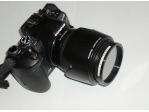Atelier Bonryu(E)
infrared photography


Atelier Bonryu(E)
infrared photography


Laboratory: Infrared Photography
1-2 Digital Infrared Photography - DIRP
Digital Infrared Photography(DIP): Though human eyes cannot directly receive information carried on the infrared (IR) or the ultraviolet (UV) lights, sensors of digital cameras (CCD, MOS) can detect such lights. Especially, to the infrared lights these sensors are highly sensitive over a wide range of the wavelength. In a digital camera, therefore, usually an IR cutoff filter (hot mirror filter, IR cut filter) is placed in front of a sensor to block IR lights so that an image produced only by visible lights are detected. However, this IR cutoff filter cannot block completely the infrared lights incident to the camera and a small amount of the infrared lights passes through the filter and reaches the sensor with the visible lights. Consequently, we can take a digital infrared photograph only by removing the predominantly abundant visible lights by using a visible light cutoff filter. Because this method is a sort of like taking an infrared photograph relying on the incompleteness of the IR cutoff filter, the intensity of the IR lights reaching the sensor is scarce and slow shutter speed is inevitable to take a photograph. As an overall sensitivity to infrared light strongly depends on cameras, it may be said that the sensitivity of the infrared light of an expensive camera with a high performance infrared cutoff filter is lower than inexpensive ones. But it is not necessarily true, and there are sometimes an expensive camera by which we can take an infrared photograph rather easily without the conversion described later.
If one would take an infrared photograph with faster shutter speed it is advised to replace the IR cutoff filter placed in front of a sensor of a camera by a visible light cutoff filter or a clear glass filter (conversion of a camera). The IR photography by using an IR converted camera will be described later (2-4).
By the way, usually there is an optical low pass filter (olpf) in front of the sensor for anti-aliasing purpose. The IR cut filter is often integrated with this olpf, but it should be noted that these are different filters.

Fig.1-4 An Olympus E-510 camera with an external visible light cutoff filter
Analog and Digital Infrared Photography: Before a digital camera became popular an infrared photograph was taken by an analog camera using an infrared film. However, taking an infrared photograph becomes extremely easier and power of expression is enhanced greatly by the advent of a digital camera. Recently a new area of the photographic art of the digital infrared photography is formed and many photographers are taking infrared photographs.
Differences between the digital and the analog infrared photography are summarized as follows. Firstly, to take an infrared photograph by a digital camera we use the same sensor of the camera for the visible light photography though we use a dedicated infrared film different from a usual film for the visible light photography in the case of the analogue infrared photography. Originally, a film was sensitive only to a light with very short wavelength. By the invention of a panchromatic film we became able to take a photograph of the full wavelength range of the visible light. After that a film for the infrared photography was invented. Basically, films were not good at photography with a longer wavelength light. In comparison with a film for an infrared photograph a sensor of digital cameras is sensitive over a wider range of the light wavelength deep into the region of the infrared light. Therefore, by a digital camera we can take a photograph with fully infrared characteristic quality. Moreover, one should get down with taking a photographs for one roll of an IR film when one start photographing in the case of a silver film and an IR film is apt to be suffered by high temperature. The digital infrared photography is free from these difficulties.
In the next place, it should be noted that there is no “color” corresponding to a infrared light as we cannot perceive the infrared light. When we take a “monochromatic” infrared photograph this fact does not bring large difference between the analogue and the digital photographs. But it brings a large difference when we take a “color” infrared photograph. A color film for the infrared photograph is constituted from three layers like a usual color film for a visible light photograph (Remark #1). In the usual color film the three layers correspond to three primary colors, i.e., blue (B), green (G), and red (R). In the case of an infrared color film, however, the first layer is colored red by the incident infrared light, the second layer is colored green by the visible red light, and the third layer is colored blue by the green light, where the incident blue light is blocked by a yellow filter at the surface of the film. When we take an infrared photograph by using a digital camera, an image is decomposed to three channels, R, G, and B, by the Bayer filters set in front of the sensor, which correspond to the visible three primary colors and a final image is obtained by recomposing the three images of R, G, and B. As one can choose colors of the three channels freely to recompose the image, the digital infrared photography has higher degree of freedom to finish a false color infrared photograph in comparison with the infrared photography by an analogue camera.
Thus, the color expressed on an infrared photograph is an artificial “false” color and for expressing such a color, usually, some post-processing is necessary, which is most easily carried out by a combination of a digital camera and a personal computer. We can see a digital infrared photograph taken as it is which is usually tinctured with red or brown. This tincture is not, of course, the color of the infrared light.




